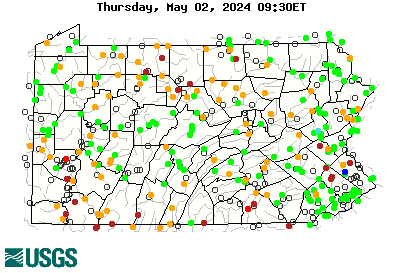HopBack
Well-known member
- Joined
- Aug 5, 2013
- Messages
- 1,076
I had not been fishing yet in 2025 until yesterday. What changed? Not the 32 degree air temps. My dog got sprayed by a skunk on Thursday morning and I have been cleaning her and the house to no avail since. Let me just tell you that’s what cabin fever really feels like!
So I headed out in search of some ice free flowing water and solidarity. Mostly, for everyone else’s sake. One whiff of me would send anyone running.
When I got to the river I decided that it may be better to try fishing the bobber instead of my usual tight line nymphing approach. I’ve never been a huge fan of bobber fishing, not because of the idea of using a bobber but rather I feel I have less control over the presentation of my flies. I don’t even think I used the bobber that much when I first started fly fishing. At any rate, I chose indicator fishing on this day because I just really wanted a relaxing day of fishing. Watching a bobber float down stream and waiting for it to go under fit the bill.
I started off using a #10 stone fly nymph and a #14 flashback pheasant tail. At first the fishing was slow until added some shot to the mixture. I felt my flies were decently weighted and getting down but the extra shot slowed the drift and action began to pick up.
To my surprise I quickly put a dozen wild browns and bows to hand all on the pheasant tail nymph. After a tangle I swapped out the stonefly for a #12 guides choice hares ear soft hackle. I have never tied/used this fly before in my life but the next 8 trout caught ignored the PT nymph and went for the guides choice. It’s certainly a buggier fly than the PT but I was shocked that the trout selected that fly over the PT that had been working so well. I did change depths on the indicator frequently to match the different water levels I was fishing and almost all of the takes were a very subtle movement on the bobber. Not your typical bobber down situation to say the least but I had blast on a cold February day. Here are a few stream side pics to help anyone who also may be experiencing cabin fever.




So I headed out in search of some ice free flowing water and solidarity. Mostly, for everyone else’s sake. One whiff of me would send anyone running.
When I got to the river I decided that it may be better to try fishing the bobber instead of my usual tight line nymphing approach. I’ve never been a huge fan of bobber fishing, not because of the idea of using a bobber but rather I feel I have less control over the presentation of my flies. I don’t even think I used the bobber that much when I first started fly fishing. At any rate, I chose indicator fishing on this day because I just really wanted a relaxing day of fishing. Watching a bobber float down stream and waiting for it to go under fit the bill.
I started off using a #10 stone fly nymph and a #14 flashback pheasant tail. At first the fishing was slow until added some shot to the mixture. I felt my flies were decently weighted and getting down but the extra shot slowed the drift and action began to pick up.
To my surprise I quickly put a dozen wild browns and bows to hand all on the pheasant tail nymph. After a tangle I swapped out the stonefly for a #12 guides choice hares ear soft hackle. I have never tied/used this fly before in my life but the next 8 trout caught ignored the PT nymph and went for the guides choice. It’s certainly a buggier fly than the PT but I was shocked that the trout selected that fly over the PT that had been working so well. I did change depths on the indicator frequently to match the different water levels I was fishing and almost all of the takes were a very subtle movement on the bobber. Not your typical bobber down situation to say the least but I had blast on a cold February day. Here are a few stream side pics to help anyone who also may be experiencing cabin fever.





